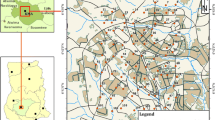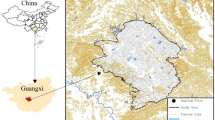Abstract
Incidental soil ingestion is a common contaminant exposure pathway for humans, notably children. It is widely accepted that the inclusion of total soil metal concentrations greatly overestimates the risk through soil ingestion for people due to contaminant bioavailability constraints. The assumption also assumes that the contaminant distribution and the bioaccessible fraction is consistent across all particle sizes. In this study, we investigated the distribution of arsenic across five particle size fractions as well as arsenic bioaccessibility in the <250-, <100-, <10- and 2.5-μm soil particle fractions in 50 contaminated soils. The distribution of arsenic was generally uniform across the larger particle size fractions but increased markedly in the <2.5-μm soil particle fraction. The marked increase in arsenic concentration in the <2.5-μm fraction was associated with a marked increase in the iron content. Arsenic bioaccessibility, in contrast, increased with decreasing particle size. The mean arsenic bioaccessibility increased from 25 ± 16% in the <250-μm soil particle fraction to 42 ± 23% in the <10-μm soil particle fraction. These results indicate that the assumption of static arsenic bioaccessibility values across particle size fractions should be reconsidered if the ingested material is enriched with small particle fractions such as those found in household dust.

Similar content being viewed by others
References
Basta, N. T., Rodriguez, R. R., & Casteel, S. W. (2001). Bioavailability and risk of arsenic exposure by the soil ingestion pathway. In W. T. Frankenberger Jr. (Ed.), Environmental chemistry of arsenic. New York: Marcel Dekker.
Belluck, D. A., Benjamin, S. L., Baveye, P., Sampson, J., & Johnson, B. (2003). Widespread arsenic contamination of soils in residential areas and public spaces: An emerging regulatory or medical crisis? International Journal of Toxicology, 22, 109–128.
Bright, D. A., Richardson, G. M., & Dodd, M. (2006). Do current standards of practice in Canada measure what is relevant to human exposure at contaminated sites? I: A discussion of soil particle size and contaminant partitioning in soil. Human and Ecological Risk Assessment, 12, 591–605.
Cai, Y., Cabrera, J. C., Georgiadis, M., & Jayachandran, K. (2002). Assessment of arsenic mobility in the soils of some golf courses in South Florida. The Science of the Total Environment, 291, 123–134.
Duggan, M. J., Inskip, M. J., Rundle, S. A., & Moorcroft, J. S. (1985). Lead in playground dust and on the hands of schoolchildren. The Science of the Total Environment, 44, 65–79.
Edwards, R. D., Yurkow, E. J., & Lioy, P. J. (1998). Seasonal deposition of housedusts onto household surfaces. The Science of the Total Environment, 224, 69–80.
Ellice, M. C., Dowling, K., Smith, J., Smith, E., & Naidu, R. (2001). Abandoned mine tailings with high arsenic concentrations: A case study with implications for regional Victoria. In Proceedings of arsenic in the Asia-Pacific region: Managing arsenic for our future (p. 124), 20–23 Nov 2001, Adelaide, South Australia.
Gee, G. W., & Bauder, J. W. (1986). Particle-size analysis. In Klute, A. (Ed.), Methods of soil analysis. Part 1. Agronomy Monograph 9 (2nd ed., pp. 383–411). Madison, WI: ASA and SSSA.
Hund-Rinke, K., & Kördel, W. (2003). Underlying issues in bioaccessibility and bioavailability: Experimental methods. Ecotoxicology and Environmental Safety, 56, 52–62.
Hunt, A., Johnson, D. L., Thornton, I., & Watt, J. M. (1993). Apportioning the sources of lead in house dusts in the London Borough of Richmond, England. The Science of the Total Environment, 138, 183–206.
Juhasz, A. L., Smith, E., Weber, J., Rees, M., Rofe, A., Kuchel, T., et al. (2007a). Comparison of in vivo and in vitro methodologies for the assessment of arsenic bioavailability in contaminated coils. Chemosphere, 69, 961–966.
Juhasz, A. L., Smith, E., Weber, J., Rees, M., Rofe, A., Kuchel, T., et al. (2007b). In vitro assessment of arsenic bioaccessibility in contaminated (anthropogenic and geogenic) soils. Chemosphere, 69, 69–78.
Kelley, M. E., Brauning, S. E., Schoof, R. A., & Ruby, M. V. (2002). Assessing oral bioavailability of metals in soil. Columbus, OH: Battelle Press.
Laird, B. D., van de Wiele, T. R., Corriveau, M., Jamieson, H. E., Parsons, M. B., Verstraete, W., et al. (2007). Gastrointestinal microbes increase arsenic bioaccessibility of ingested mine tailings using the simulator of the human intestinal microbial system. Environmental Science & Technology, 41, 5542–5547.
Lanphear, B. P., & Roghmann, K. L. (1997). Pathways of lead exposure in urban children. Environmental Research, 74, 67–73.
Lien, H. C., Tsai, T. F., Lee, Y. Y., & Hsiao, C. H. (2001). Merkel cell carcinoma and chronic arsenicism. Journal of American Academy of Dermatology, 41, 641–643.
Lioy, P. J., Freeman, N. C. G., & Millette, J. R. (2002). Dust: A metric for use in residential and building exposure assessment and source characterization. Environmental Health Perspectives, 110, 969–983.
Lombi, E., Sletten, R. S., & Wenzel, W. W. (2000). Sequentially extracted arsenic from different size fractions of contaminated soils. Water, Air, and Soil Pollution, 124, 319–332.
Mandal, B. K., & Suzuki, K. T. (2002). Arsenic round the world: A review. Talanta, 58, 201–235.
McLaren, R. G., Naidu, R., Smith, J., & Tiller, K. G. (1998). Fractionation and distribution of arsenic in soils contaminated by cattle dip. Journal of Environment Quality, 27, 348–354.
Mukerjee, D. (1998). Assessment of risk from multimedia exposures of children to environmental chemicals. Journal of the Air & Waste Management Association, 48, 483–501.
NEPC (National Environmental Protection Council). (1999). National environmental protection measure for the assessment of site contamination, Schedule B1 (pp. 1–12). Adelaide, Australia: National Environmental Protection Council Service Corporation.
Pouschat, P., & Zagury, G. J. (2006). In vitro gastrointestinal bioavailability of arsenic in soils collected near CCA-treated utility poles. Environmental Science & Technology, 40, 4317–4323.
Roberts, S. M. (2004). Incorporating information on bioavailability of soil-bourne chemicals into human health risk assessments. Human and Ecological Risk Assessment, 10, 631–635.
Rodriguez, R., Basta, N. T., Casteel, S. W., & Pace, L. W. (1999). An in vitro gastrointestinal method to estimate bioavailable arsenic in contaminated soil and solid media. Environmental Science & Technology, 33, 642–649.
Rodriguez, R. E., Basta, N. T., Ward, D. C., Casteel, S. W., & Pace, L. W. (2003). Chemical extraction methods to assess bioavailable As in contaminated soil and solid media. Journal of Environment Quality, 32, 876–884.
Ruby, M. V. (2004). Bioavailability of soil-borne chemicals: Abiotic assessment tools. Human and Ecological Risk Assessment, 10, 647–656.
Ruby, M. V., Davis, A., Schoof, R., Eberle, S., & Sellstone, C. M. (1996). Estimation of lead and arsenic bioavailability using a physiologically based extraction test. Environmental Science & Technology, 30, 422–430.
Simon, D. L., Maynard, E. J., & Thomas, K. D. (2007). Living in a sea of lead—changes in blood- and hand-lead of infants living near a smelter. Journal of Exposure Science and Environmental Epidemiology, 17, 248–259.
Smith, E., Naidu, R., & Alston, A. M. (1999). Chemistry of arsenic in soils: I. Sorption of arsenate and arsenite by four Australian soils. Journal of Environment Quality, 28, 1719–1726.
Smith, E., Naidu, R., & Alston, A. M. (2002). Chemistry of inorganic arsenic in soils: II. Effect of P, Na and Ca. Journal of Environment Quality, 31, 557–563.
Smith, E., Smith, J., Smith, L., Biswas, T., Correll, R., & Naidu, R. (2003). Arsenic in Australian environment: An overview. Journal of Environmental Science and Health Part A, A38, 223–239.
Smith, E., Smith, J., & Naidu, R. (2006). Distribution and nature of arsenic along former railway corridors of South Australia. The Science of the Total Environment, 363, 175–182.
Smith, E., Naidu, R., Weber, J., & Juhasz, A. L. (2008). The impact of sequestration on the bioaccessibility of arsenic in long-term contaminated soils. Chemosphere, 71, 773–780.
Subacz, J. L., Barnett, M. O., Jardine, P. M., & Stewart, M. A. (2007). Decreasing arsenic bioaccessibility/bioavailability in soils with iron amendments. Journal of Environmental Science and Health Part A, 42, 1317–1329.
Tang, X. Y., Zhu, Y. G., Shan, X. Q., McLaren, R., & Duan, J. (2007). The ageing effect on bioaccessibility and fractionation of arsenic in soils from China. Chemosphere, 66, 1183–1190.
Yamamoto, N., Takahashi, Y., Yoshinaga, J., Tanaka, A., & Shibata, Y. (2006). Size distributions of soil particles adhered to children’s hands. Archives of Environmental Contamination and Toxicology, 51, 157–163.
Yang, J. K., Barnett, M. O., Jardine, P. M., Basta, N. T., & Casteel, S. W. (2002). Adsorption, sequestration, and bioaccessibility of As(V) in soils. Environmental Science & Technology, 36, 4562–4569.
Acknowledgements
The authors would like to thank the Cooperative Research Centre for Contamination Assessment and Remediation of the Environment and the University of South Australia for making this research possible.
Author information
Authors and Affiliations
Corresponding author
Rights and permissions
About this article
Cite this article
Smith, E., Weber, J. & Juhasz, A.L. Arsenic distribution and bioaccessibility across particle fractions in historically contaminated soils. Environ Geochem Health 31 (Suppl 1), 85–92 (2009). https://doi.org/10.1007/s10653-009-9249-2
Received:
Accepted:
Published:
Issue Date:
DOI: https://doi.org/10.1007/s10653-009-9249-2




